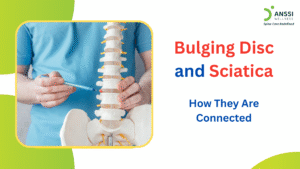Bulging discs are one of the most commonly misunderstood spinal conditions. Despite affecting a large number of people, they are often surrounded by confusion and misinformation. This lack of clarity can lead to fear, misdiagnosis, or unnecessary treatments.
For individuals living with chronic back or neck pain, understanding what a bulging disc truly is and isn’t can make a significant difference. So, let’s separate myth from fact and offer a clearer understanding of this condition and its treatment options.
What is a Bulging Disc?
A bulging disc occurs when a spinal disc, the soft, cushion-like structure between the vertebrae, protrudes beyond its normal boundary.
Unlike a herniated disc, in which the disc’s inner material leaks out due to a rupture, a bulging disc retains its outer layer. This protrusion can sometimes press on nearby nerves, leading to discomfort, pain, or numbness.
However, not all bulging discs cause symptoms, and many people may have them without even knowing it.
Myth 1: Bulging Discs Always Cause Pain
Fact: This is one of the most persistent misconceptions. In reality, many individuals with bulging discs experience no pain or symptoms at all. Studies have shown that a large percentage of adults, especially as they age, develop disc bulges as a natural part of spinal wear and tear. These are often found incidentally during scans for unrelated issues.
Pain or neurological symptoms usually occur only when the bulging disc presses against a nerve root or the spinal cord, leading to inflammation or nerve compression. Therefore, the presence of a bulging disc on an MRI does not always correlate with pain or require aggressive treatment.
Myth 2: Bulging Discs Only Affect the Elderly
Fact: While age-related disc degeneration is a leading cause of bulging discs, they are not exclusive to older adults.
In today’s digital age, younger people are increasingly being diagnosed with bulging discs due to poor posture, sedentary lifestyles, and extended hours spent hunched over screens.
Sports injuries, sudden trauma, and repetitive strain can also lead to disc problems in younger individuals. It’s not uncommon to see patients in their 20s or 30s presenting with disc bulges, especially those working long hours in desk jobs or engaging in improper workout routines without adequate warm-up or form.
Myth 3: If You Have a Bulging Disc, You Should Rest Completely
Fact: While rest is important during acute flare-ups, prolonged inactivity can do more harm than good. Extended bed rest can lead to muscle weakening, joint stiffness, and a slower recovery. Inactivity may worsen the condition or lead to other health issues, including weight gain and reduced cardiovascular health.
Gentle movement, guided physiotherapy, and controlled exercise are essential to maintaining spinal flexibility and strengthening supportive muscles. The key is to stay active within safe limits, under the supervision of a qualified spine specialist or physiotherapist.
Myth 4: Surgery is the Only Solution
Fact: Surgery is rarely the first line of treatment for bulging discs. In fact, the majority of cases respond well to conservative, non-surgical treatments.
The most important non-surgical interventions include:
- Physiotherapy: Targeted exercises help strengthen the muscles that support the spine, improve posture, and relieve pressure on affected discs.
- Posture Correction: Proper ergonomic habits during daily activities, especially for office workers, can significantly reduce strain on the spine.
- Lifestyle Modifications: Maintaining a healthy weight, staying active, and avoiding smoking all contribute to spinal health and recovery.
- Pain Management: Temporary use of medications or heat/cold therapy can help manage inflammation and discomfort.
- Non-Surgical Spinal Decompression Treatment: This proven and effective option involves a USA-based protocol that gently stretches the spine, reducing pressure on the disc and helping it return to its normal position.
Surgical intervention is typically considered only when non-surgical methods fail after several months, or if there is progressive neurological loss such as weakness or bowel/bladder dysfunction.
About ANSSI:
ANSSI Wellness focuses on improving the quality of life for patients suffering from spinal issues, aiming to provide relief where other conventional treatments have failed. Through advanced non-surgical spinal decompression treatment, ANSSI is committed to helping patients avoid surgery and recover in a safe, effective, and compassionate environment.
Connect with ANSSI Wellness on LinkedIn, Instagram, and Facebook for expert guidance.



